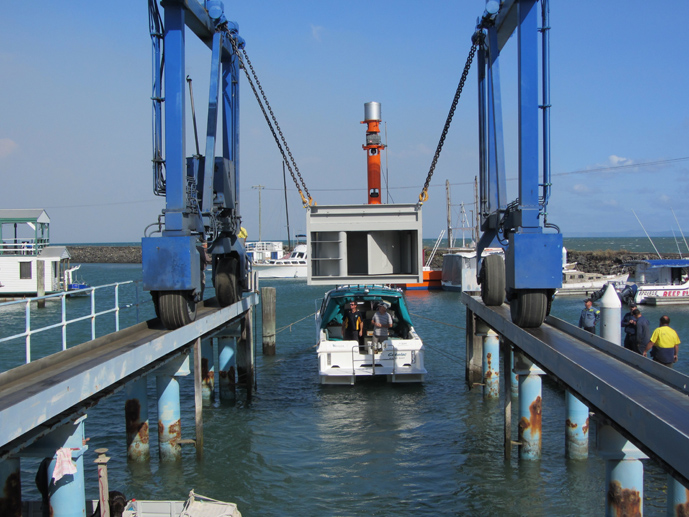Australian farmer revolutionizes water-turbine technology


MELBOURNE -- Fred Sundermann, an Australian farmer with a long history in design and innovations, has developed a bi-directionally low-head water turbine designed to maximize operational efficiency in slow water flows.
Turbines have been around for more than a century, but Sundermann Water Power (SWP) Limited (the business backing the technology) claims that the Sundermann Turbine (S-Turbine) is the most efficient in harnessing the power of water.
“The problem today is that all existing lo-tech turbine systems throughout the world are inefficient as such whereby the water that hits the blade flows either passes through or around the blade, thus making them inefficient,” SWP Chairman Mr Ed Gibson said in a video interview.
As detailed on the SWP website, the key to the turbine technology is in its gearbox and blade systems:
The turbine has a unique design in that its efficiency is achieved by the tilting of the power blades during the rotating cycle. The blades rotate half a revolution for each full rotation of the central shaft. This configuration allows each blade to contribute a unidirectional force to the central shaft, for virtually the entire rotational cycle. In this way they can efficiently utilize the kinetic energy of the moving water. The central shaft works the generator via a gearbox to produce emission free renewable energy. Electrical power is generated at a voltage of 690V.
The idea for a micro-hydro turbine system was first conceived by Mr Sundermann 10 years ago in Heyfield, Victoria. Later in 2006, he developed the first working prototype out of bike chains and although the turbine could only produced 1 KW of power, it proved that his design worked (see this video for a quick demo of the turbine in action).
The latest S-Turbine prototype, the T3, measuring 2.44 m high, 2.2 m long and 2 m wide, is made out of iron, recycled plastic and 2pac, a water resistant paint. SWP is currently investigating stainless steel options for future prototypes.
Last year, SWP tested the T3 in Hervey Bay, Queensland, to confirm that it was a fully functional turbine, with no inhibitors to the free rotation of the blades and gears while in operation.
The test was considered a success by the SWP, based on the proven operational functioning of the turbine, and it reaching, at times optimum performance for the fitted generators and consistently 70% of the generators maximum output.
The turbine was able to power three standard hot water system heater (elements) at a rate considered equal to that achievable with mains power in a typical household. It generated up to 6 KW of power with the ability to increase exponentially.
SWP has indicated that "The Sundermann Turbine is suitable for installations where water flow is either: in a single direction, such as rivers or ocean currents, or in tidal areas where the water flow reverses direction approximately every six hours."
Running 24-hours a day, each turbine delivers up to 100 KW of power and multiple turbines can be combined to form a larger working unit, or ‘bank’ delivering up to 1 MW per bank.
“Scale them up to any size, if we have a big river, we can have them built into a weir shape; if there are big tidal differences, you can build them big. The blades are just doors virtually –- depending on the water floor,” Mr Sundermann said.
But there are some limitations to the turbine technology, namely its reliance on water flow and stable surfaces. “The water has to be 5 km of water speed, and the limitations are that we can’t put it in rivers with soft banks, it needs to have a solid base," Mr Sundermann explained.
SWP indicated that the turbine is ideal for places with high rainfall such as Brazil, Argentina, Peru, Chile New Guinea and places in South-East Asia.
Portable and cost-effective, the water turbine is a particularly viable energy alternative for remote and isolated communities where infrastructure is not well developed.
"They are a plug-in power as they are dropped into a river stream and immediately start generating power that is free and renewable energy, and it lowers the use of diesel fuels, so we think we have fantastic potential for global application for that," SWP Director Mr Leigh Benett said in an ABC Rural Report.
The SWP organization is currently going through the process of a Commercialization Australia grant and have reached stage two. Further testing of the turbine will ensure its reliability.
“We have proved it works, but we have to have it tested long term, so we know the bearings are OK and everything is right,” Mr Sundermann said. “We have to walk before we run, and we have to perfect the little ones before we get the big ones going,” Mr Sundermann said.
Photos: Sundermann Water Power.
This post was originally published on Smartplanet.com
